Electrical Characteristics and Desaturation Effectiveness During Horizontal Electrolysis in Calcareous Sand
Abstract
1. Introduction
2. Experimental Methods
2.1. Experimental Principle
2.2. Experimental Materials andApparatus
2.3. Soil Layer Characterization
2.4. Test Conditions
3. Results
3.1. Electrical Characteristics of Calcareous Sand During Electrolysis Desaturation
3.2. Saturation Changes in Calcareous Sand Under Electrolysis Desaturation
3.3. Theoretical Calculation of Gas Content
4. Discussion
4.1. Differential Analysis of the Saturation Exponent
4.2. Deviations from Archie’s Assumptions in Calcareous Sand
4.3. Analysis of Electricity Consumption
5. Conclusions
- The resistivity of the calcareous sand column model was influenced by the coupling of temperature and gas content, and its variation process could be divided into three stages. In the first stage, the resistivity changes were mainly dominated by gas content, and the resistivity increased. In the second stage, as the temperature increased, the resistivity changes were influenced by temperature, and the rate of increase in resistivity tended to slow. In the third stage, the resistivity changes were influenced by both temperature and gas content, and the resistivity tended to stabilize.
- During the electrolysis process, the saturation variation of the soil layer near the electrode was more significant than that of the middle soil layer, which exhibited relatively stable saturation changes. As current intensity increased, the difference in saturation between the soil layer near the electrode and the middle soil layer increased. The saturation redistributed upon cessation of electrolysis. As soil depth decreased, the increase in saturation diminished, and the saturation at the top of the soil decreased.
- Gas generated by electrolysis at lower current intensity did not readily form gas channels, leading to more efficient gas retention within the sand, which may continue to reduce saturation levels.
- The reliability of saturation calculations based on temperature-corrected resistivity variations was verified through comparative analysis of electrolysis-induced drainage volumes. For calcareous sand’s unique properties, an electrolytic influence coefficient for Archie’s formulation was proposed to accommodate electrolysis conditions, establishing a quantitative relationship between resistivity and saturation during electrolysis. This provides the theoretical foundation for saturation prediction in electrolytic desaturation methods.
- The analysis of the saturation exponent B indicates that Archie’s law parameter B is influenced by both the physical properties of calcareous sand and the characteristics of the pore fluid. Therefore, calibration of the B-value is crucial for assessing the saturation of calcareous sand in marine environments.
Author Contributions
Funding
Data Availability Statement
Conflicts of Interest
Abbreviations
| SC | Stone columns |
| LRR | Liquefaction resistance ratio |
| MICP | Microbially induced carbonate precipitation |
| 1H L-F NMR | Low-field nuclear magnetic resonance |
| SEM | Scanning electron microscopy |
| DC | Direct current |
References
- Wang, X.Z.; Wang, X.; Jin, Z.C.; Zhu, C.Q.; Wang, R.; Meng, Q.S. Investigation of Engineering Characteristics of Calcareous Soils from Fringing Reef. Ocean Eng. 2017, 134, 77–86. [Google Scholar] [CrossRef]
- Xiao, P.; Liu, H.; Xiao, Y.; Stuedlein, A.W.; Evans, T.M. Liquefaction Resistance of Bio-Cemented Calcareous Sand. Soil Dyn. Earthq. Eng. 2018, 107, 9–19. [Google Scholar] [CrossRef]
- Seed, R.B.; Cetin, K.O.; Moss, R.E.S.; Kammerer, A.M.; Wu, J.; Pestana, J.M.; Riemer, M.F.; Sancio, R.B.; Bray, J.D.; Kayen, R.E.; et al. Recent Advances in Soil Liquefaction Engineering: A Unified and Consistent Framework. Earthq. Eng. Res. Cent. 2003, 6, 1–71. [Google Scholar]
- O’Donnell, S.T.; Kavazanjian, E. The Effect of Desaturation on the Static and Cyclic Mechanical Response of Dense Sand. In IFCEE 2018; American Society of Civil Engineers: New York, NY, USA, 2018; pp. 232–241. [Google Scholar] [CrossRef]
- Wang, X.; Weng, Y.; Wei, H.; Meng, Q.; Hu, M. Particle Obstruction and Crushing of Dredged Calcareous Soil in the Nansha Islands, South China Sea. Eng. Geol. 2019, 261, 105274. [Google Scholar] [CrossRef]
- Asgari, A.; Oliaei, M.; Bagheri, M. Numerical Simulation of Improvement of a Liquefiable Soil Layer Using Stone Column and Pile-Pinning Techniques. Soil Dyn. Earthq. Eng. 2013, 51, 77–96. [Google Scholar] [CrossRef]
- Qiu, H.; Qiu, R.; Luo, G.; Ayasrah, M.; Wang, Z. Study on the Mechanical Behavior of Fluid–Solid Coupling in Shallow Buried Tunnels Under Different Biased Terrain. Symmetry 2022, 14, 1339. [Google Scholar] [CrossRef]
- Okamura, M.; Soga, Y. Effects of Pore Fluid Compressibility on Liquefaction Resistance of Partially Saturated Sand. Soils Found. 2006, 46, 695–700. [Google Scholar] [CrossRef]
- Yegian, M.K.; Eseller-Bayat, E.; Alshawabkeh, A.; Ali, S. Induced-Partial Saturation for Liquefaction Mitigation: Experimental Investigation. J. Geotech. Geoenvironmental Eng. 2007, 133, 372–380. [Google Scholar] [CrossRef]
- He, J.; Chu, J.; Ivanov, V. Mitigation of Liquefaction of Saturated Sand Using Biogas. Geotechnique 2013, 63, 267–275. [Google Scholar] [CrossRef]
- Eseller-Bayat, E.; Yegian, M.K.; Alshawabkeh, A.; Gokyer, S. Liquefaction Response of Partially Saturated Sands. I Exp. Results. J. Geotech. Geoenvironmental Eng. 2013, 139, 863–871. [Google Scholar] [CrossRef]
- Zeybek, A.; Madabhushi, S.P.G. Influence of Air Injection on the Liquefaction-Induced Deformation Mechanisms beneath Shallow Foundations. Soil Dyn. Earthq. Eng. 2017, 97, 266–276. [Google Scholar] [CrossRef]
- Okamura, M.; Ishihara, M.; Tamura, K. Degree of Saturation and Liquefaction Resistances of Sand Improved with Sand Compaction Pile. J. Geotech. Geoenviron. Eng. 2006, 132, 258–264. [Google Scholar] [CrossRef]
- Okamura, M.; Takebayashi, M.; Nishida, K.; Fujii, N.; Jinguji, M.; Imasato, T.; Yasuhara, H.; Nakagawa, E. In-Situ Desaturation Test by Air Injection and Its Evaluation through Field Monitoring and Multiphase Flow Simulation. J. Geotech. Geoenvironmental Eng. 2011, 137, 643–652. [Google Scholar] [CrossRef]
- Chen, R.; Chen, Y.; Liu, H.; Zhang, K.; Zhou, Y.; Xu, S.; Wu, K. In Situ Desaturation Tests by Electrolysis for Liquefaction Mitigation. Can. Geotech. J. 2021, 58, 1744–1756. [Google Scholar] [CrossRef]
- Chen, Y.; Han, Y.; Zhang, X.; Sarajpoor, S.; Zhang, S.; Yao, X. Experimental Study on Permeability and Strength Characteristics of MICP-Treated Calcareous Sand. Biogeotechnics 2023, 1, 100034. [Google Scholar] [CrossRef]
- Zeng, C.; Van Paassen, L.A.; Zheng, J.J.; Stallings Young, E.G.; Hall, C.A.; Veenis, Y.; Van der Star, W.R.L.; Konstantinou, M.; Kavazanjian, E. Soil Stabilization with Microbially Induced Desaturation and Precipitation (MIDP) by Denitrification: A Field Study. Acta Geotech. 2022, 17, 5359–5374. [Google Scholar] [CrossRef]
- Ji, W.; Dahmani, A.; Ahlfeld, D.P.; Lin, J.D.; Hill, E. Laboratory Study of Air Sparging: Air Flow Visualization. Groundw. Monit. Remediat. 1993, 13, 115–126. [Google Scholar] [CrossRef]
- Chen, Y.M.; He, S.K.; Fang, Z.; Jiang, Q. Field Tests on Liquefaction Resistance of Desaturation Measure of Electrolysis. Yantu Gongcheng Xuebao/Chin. J. Geotech. Eng. 2017, 39, 832–838. [Google Scholar] [CrossRef]
- Casagrande, L. Electro-Osmosis in Soils. Geotechnique 1949, 1, 159–177. [Google Scholar] [CrossRef]
- He, S.K.; Chen, Y.M.; Fang, Z. Electrical Characteristics of Electrolytic Desaturation Method for Liquefiable Foundation. Yantu Gongcheng Xuebao/Chin. J. Geotech. Eng. 2016, 38, 1434–1441. [Google Scholar] [CrossRef]
- Ding, J.; Hua, W.; Zhang, H.; Lou, Y. The Development and Application of Two Chlorine Recycling Technologies in Polyurethane Industry. J. Clean. Prod. 2013, 41, 97–104. [Google Scholar] [CrossRef]
- Zhang, Z.; Chen, Y.; Liu, H.; Zhou, Y.; Zhou, X. Resistivity Characteristics during Horizontal-Layered Electrolysis Desaturation of Calcareous Sand. Eng. Geol. 2020, 279, 105899. [Google Scholar] [CrossRef]
- Chen, R.; Chen, Y.; Liu, H.; Cai, X.; Wu, K.; Zhang, Z. Microscopic Mechanism Analysis of Calcareous Sand in Electrolysis Desaturation Using1 H L-F NMR. Can. Geotech. J. 2022, 59, 1743–1755. [Google Scholar] [CrossRef]
- Zhang, Z.; Chen, Y.; Chen, R.; Zhou, Y.; Liu, H. Saturation Characteristics during Horizontal-Layered Electrolysis Desaturation of Calcareous Sand. Comput. Geotech. 2022, 151, 104938. [Google Scholar] [CrossRef]
- Yegian, M.K.; Eseller, E.; Alshawabkeh, A. Preparation and Cyclic Testing of Partially Saturated Sands. Unsaturated Soils 2006 2006, 508–518. [Google Scholar] [CrossRef]
- Bergado, D.T.; Balasubramaniam, A.S.; Patawaran, M.A.B.; Kwunpreuk, W. Electro-Osmotic Consolidation of Soft Bangkok Clay with Prefabricated Vertical Drains. Gr. Improv. 2000, 4, 153–163. [Google Scholar] [CrossRef]
- Rhoades, J.D.; Raats, P.A.C.; Prather, R.J. Effects of Liquid-phase Electrical Conductivity, Water Content, and Surface Conductivity on Bulk Soil Electrical Conductivity. Soil Sci. Soc. Am. J. 1976, 40, 651–655. [Google Scholar] [CrossRef]
- Samouëlian, A.; Cousin, I.; Tabbagh, A.; Bruand, A.; Richard, G. Electrical Resistivity Survey in Soil Science: A Review. Soil Tillage Res. 2005, 83, 173–193. [Google Scholar] [CrossRef]
- Archie, G.E. The Electrical Resistivity Log as an Aid in Determining Some Reservoir Characteristics. Trans. AIME 1942, 146, 54–62. [Google Scholar] [CrossRef]
- McNeill, J.D. Use of Electromagnetic Methods for Groundwater Studies. Geotech. Environ. Geophys. 1990, 1, 191–218. [Google Scholar] [CrossRef]
- Waxman, M.H.; Smits, L.J.M. Electrical Conductivities in Oil-Bearing Shaly Sands. Soc. Pet. Eng. J. 1968, 8, 107–122. [Google Scholar] [CrossRef]
- Abu-hassanein, Z.S.; Benson, C.H.; Blotz, L.R. Electrical Resistivity of Compacted Clays. J. Geotech. Eng. 1996, 122, 397–406. [Google Scholar] [CrossRef]
- Helm, K.P.; Bindoff, N.L.; Church, J.A. Changes in the Global Hydrological-Cycle Inferred from Ocean Salinity. Geophys. Res. Lett. 2010, 37, 2–6. [Google Scholar] [CrossRef]
- Karl, T. Theoretical Soil Mechanics; John Wiley & Sons: New York, NY, USA, 1943. [Google Scholar]
- Cho, G.-C.; Dodds, J.; Santamarina, J.C. Particle Shape Effects on Packing Density, Stiffness, and Strength: Natural and Crushed Sands. J. Geotech. Geoenvironmental Eng. 2006, 132, 591–602. [Google Scholar] [CrossRef]
- Kherif, O.; Robson, S.; Harid, N.; Thorpe, D.; Stivanello, S.; Haddad, A. On the Impact of Soil Resistivity Measurement and Modelling on Grounding Performance. In Proceedings of the 2022 36th International Conference on Lightning Protection, Cape Town, South Africa, 2–7 October 2022; pp. 379–382. [Google Scholar] [CrossRef]
- Chen, R.; Hu, Y.; Chen, Y.; Zhou, Y. Effect of Electrolysis Desaturation Treatment on Micro-Structure of Liquefiable Silica Sands. Bull. Eng. Geol. Environ. 2024, 83, 285. [Google Scholar] [CrossRef]
- Pereira, O.C.N.; Bertonha, A.; de Freitas, P.S.L.; Silvano, C. Development and Calibration of an Electrolytic Cell for Ion Determination in a Soil Solution. Acta Sci. Technol. 2015, 37, 189. [Google Scholar] [CrossRef]
- Rittirong, A.; Shang, J.Q.; Mohamedelhassan, E.; Ismail, M.A.; Randolph, M.F. Effects of Electrode Configuration on Electrokinetic Stabilization for Caisson Anchors in Calcareous Sand. J. Geotech. Geoenvironmental Eng. 2008, 134, 352–365. [Google Scholar] [CrossRef]
- Keller, V. Electrical Methods in Geophysical Prospecting; Pergamon Press: Oxford, UK, 1966; p. 155. [Google Scholar]
- Jensen, W.B. Faradays Laws or Faradays Law? J. Chem. Educ. 2012, 89, 1208–1209. [Google Scholar] [CrossRef]

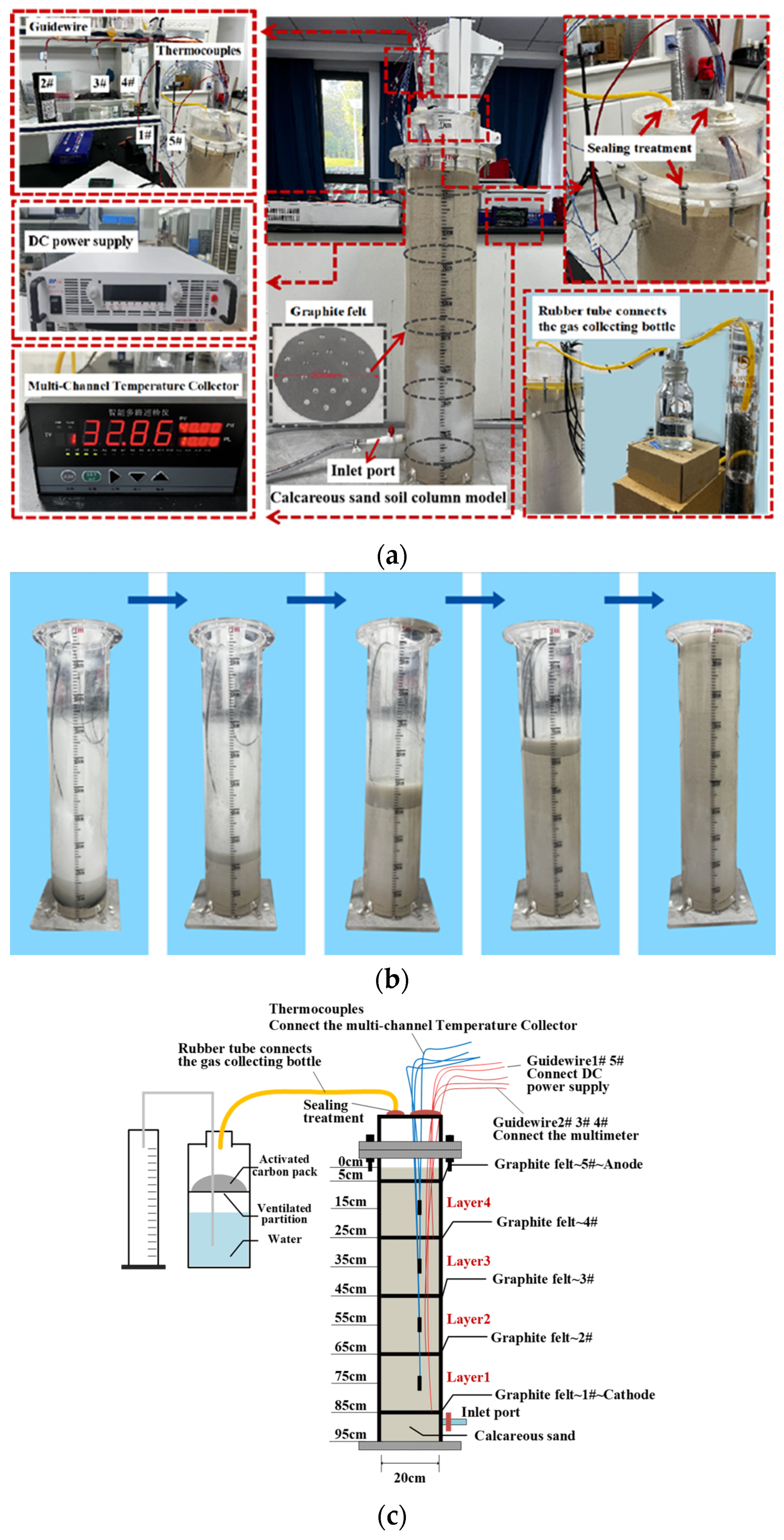
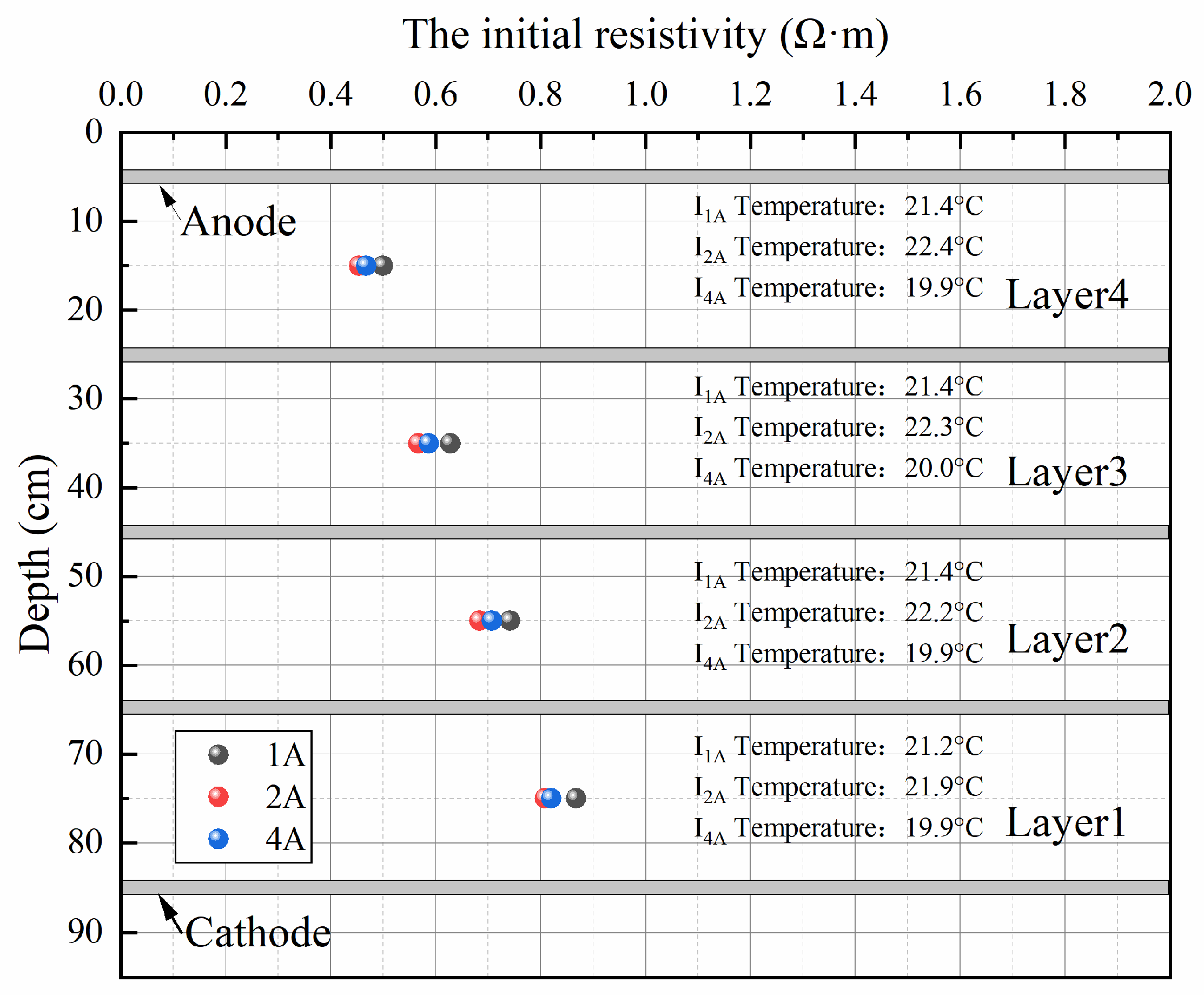
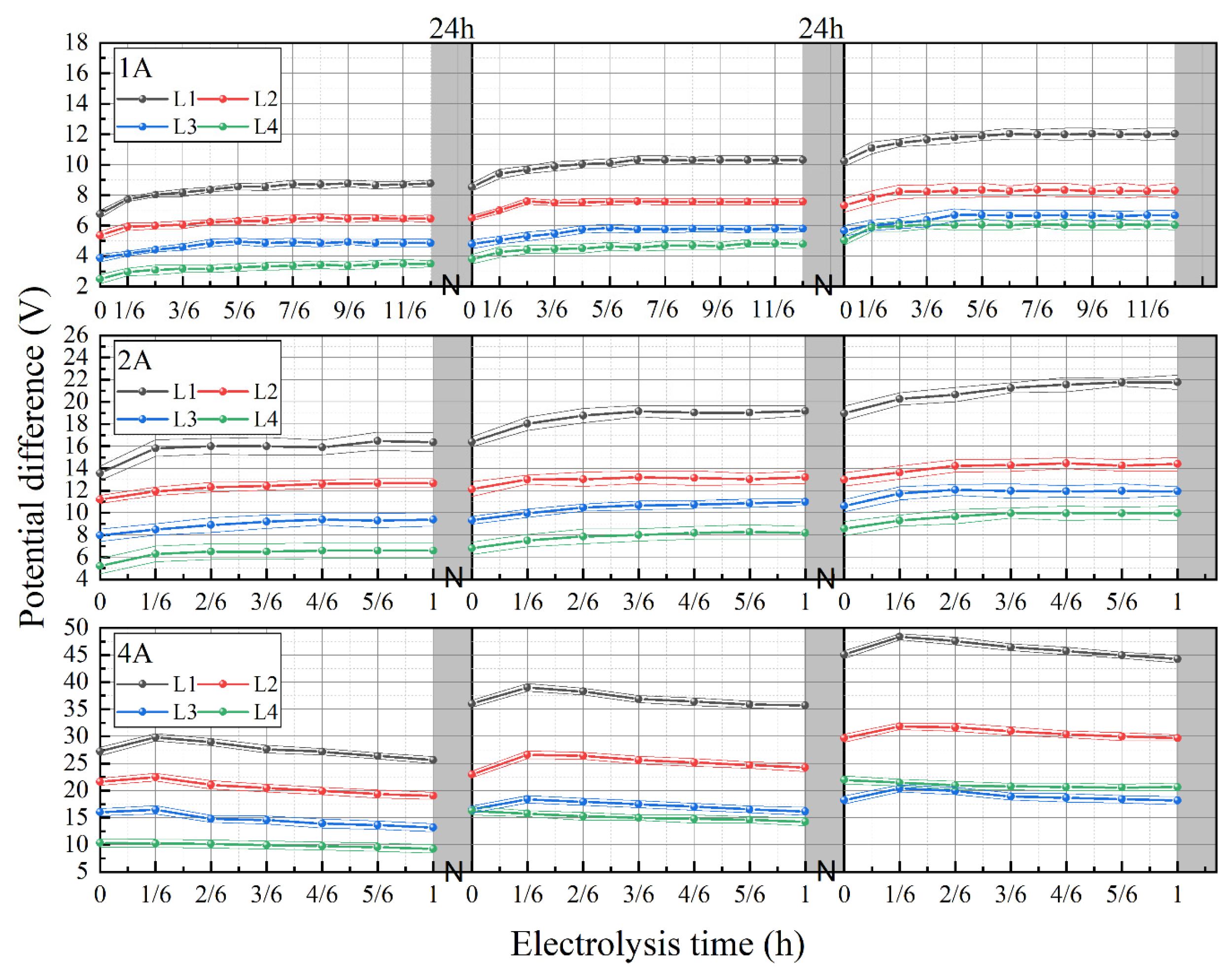



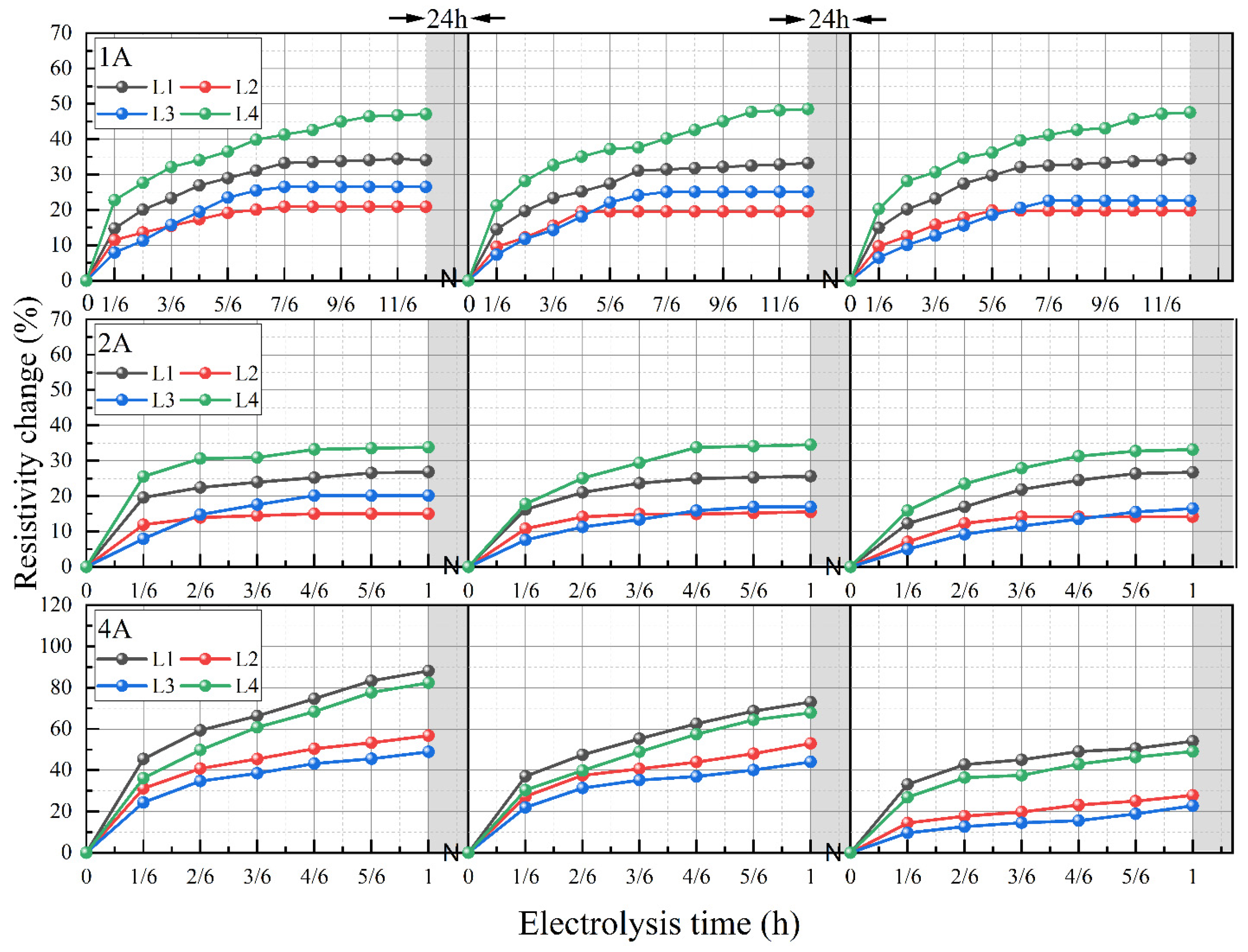
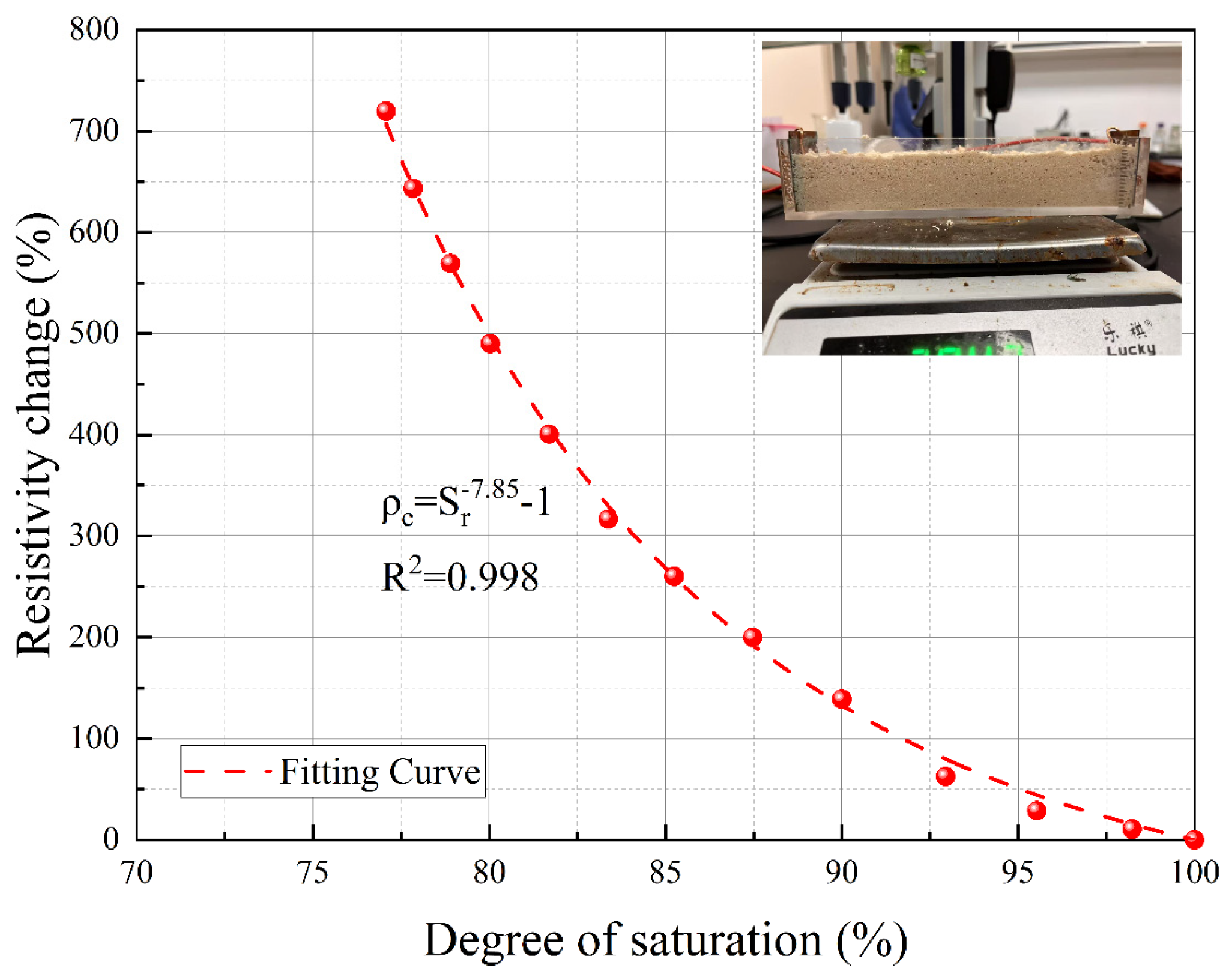

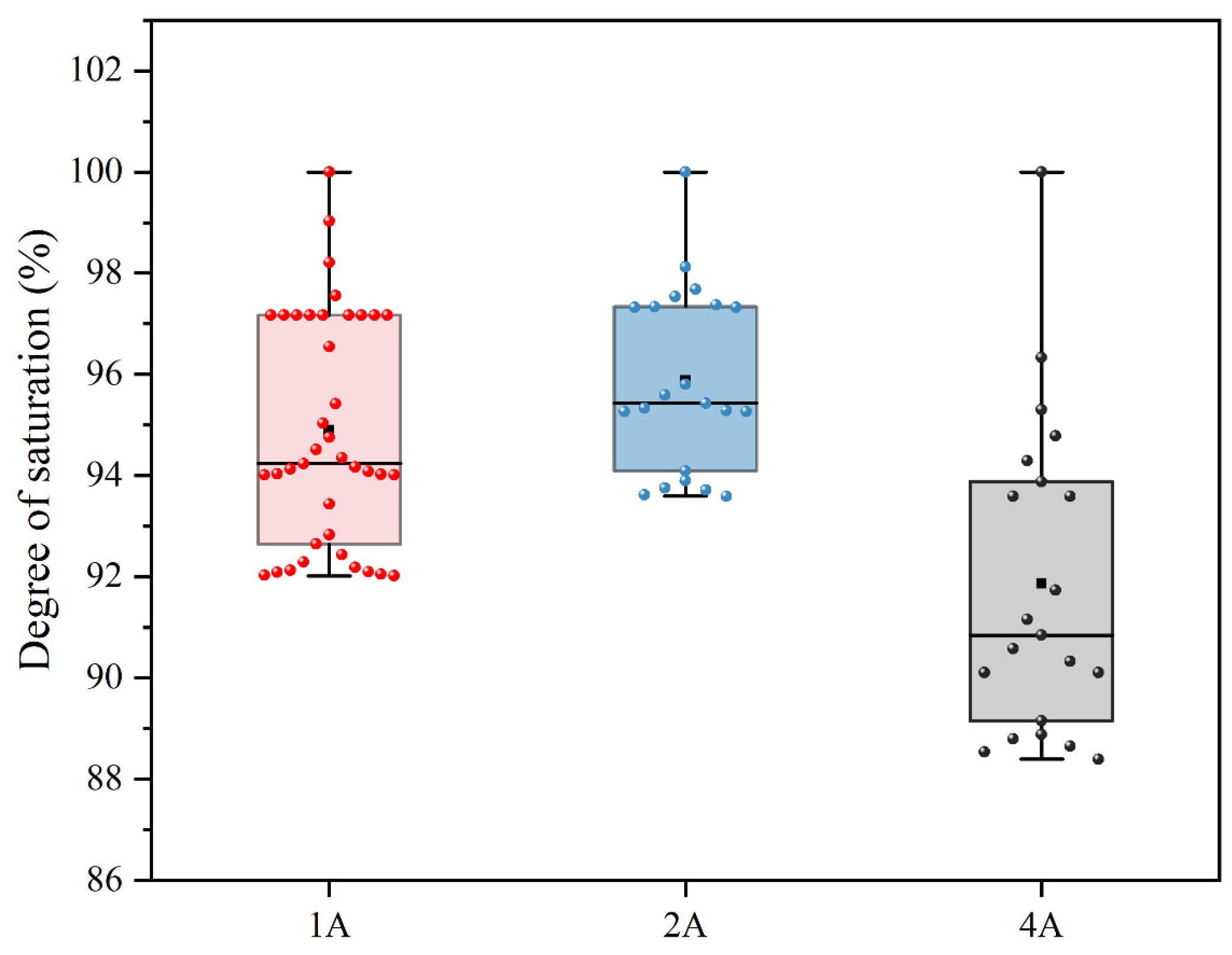
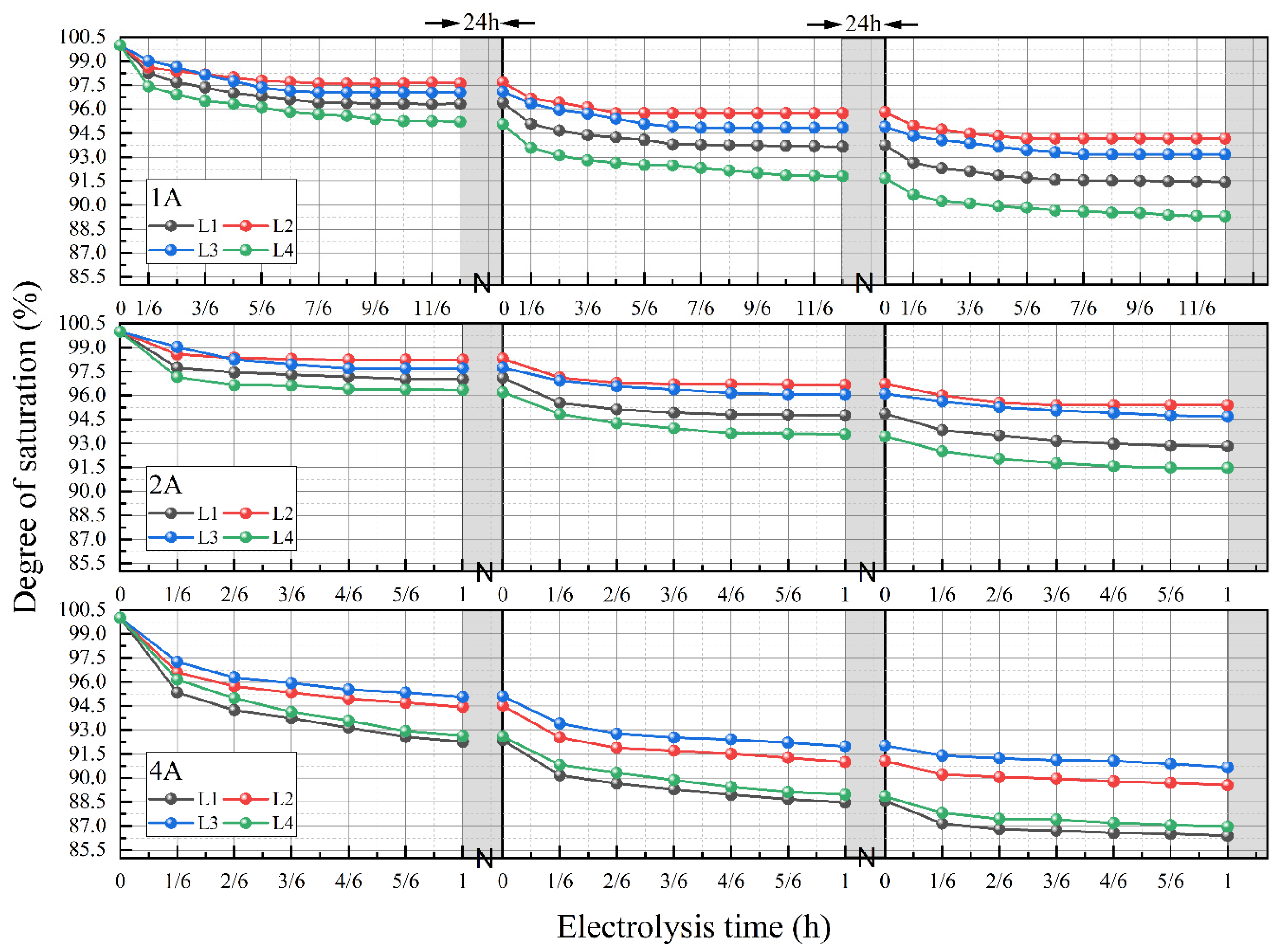

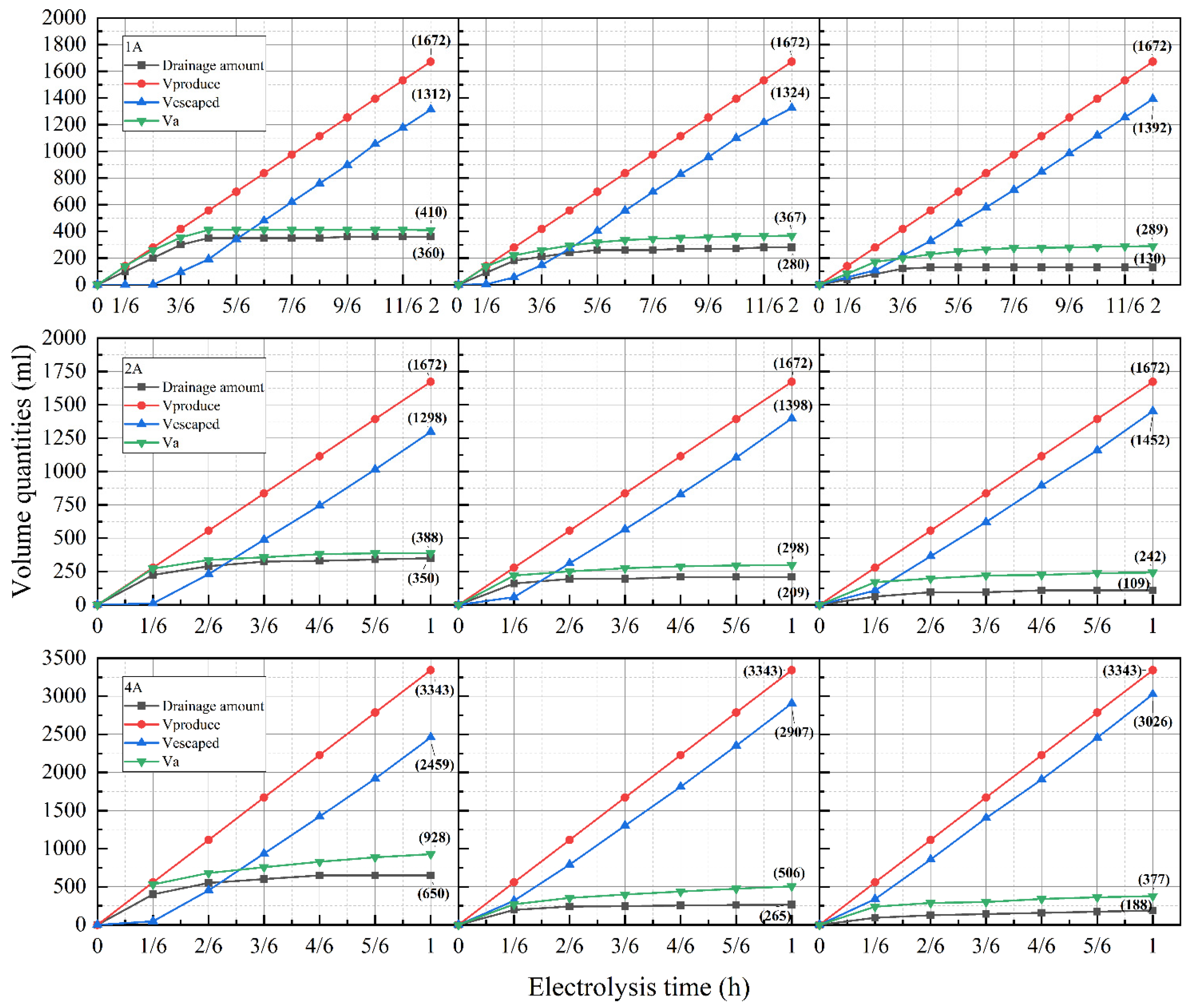
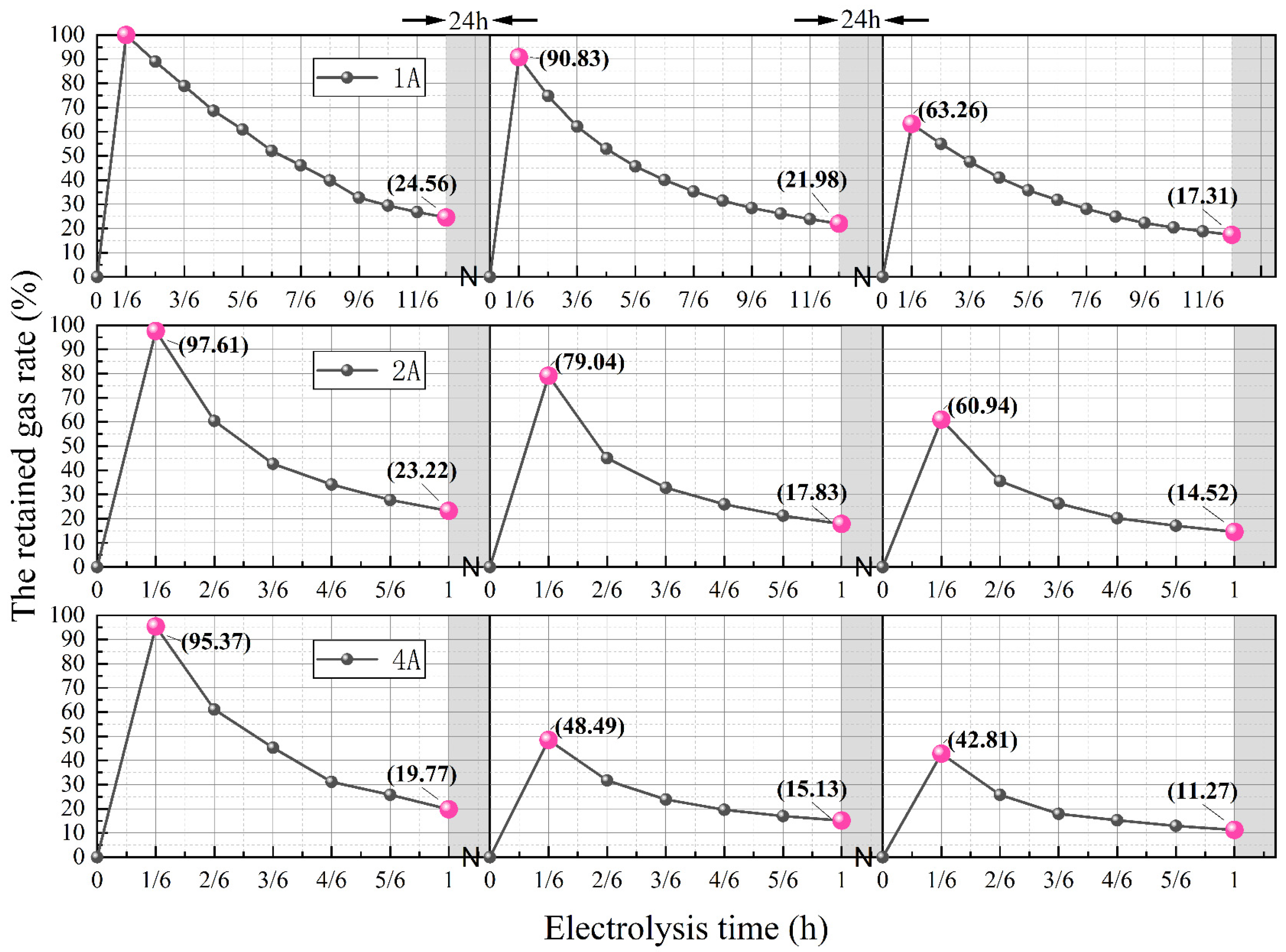
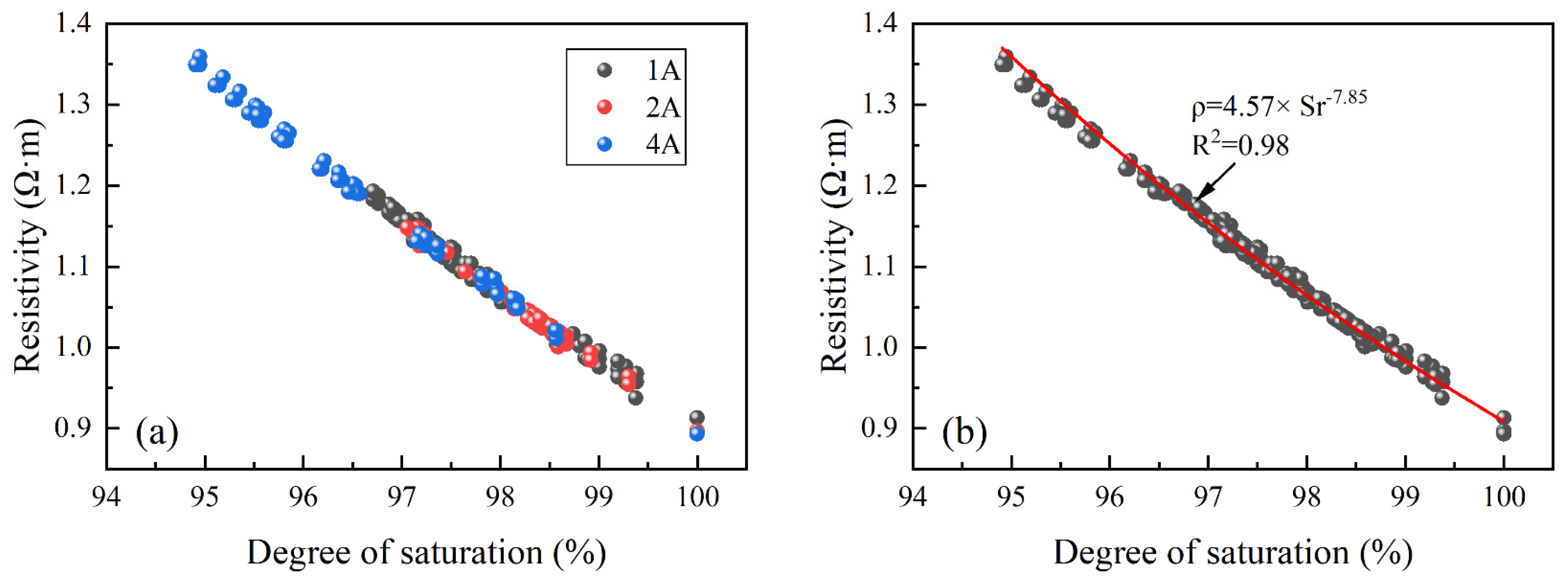


| Gs | Cu | Cc | d50 (mm) | emax | emin |
|---|---|---|---|---|---|
| 2.83 | 3.46 | 1.25 | 0.49 | 1.05 | 0.77 |
| Soil Layer Number | Depth (cm) | Effective Stress Δσ′ (kPa) | Compression Δsi (mm) | eᵢ | Dᵣᵢ (%) |
|---|---|---|---|---|---|
| 4 | 5~25 | 0.93 | 0.048 | 0.9239 | 45.04 |
| 3 | 25~45 | 2.79 | 0.145 | 0.9233 | 45.25 |
| 2 | 45~65 | 4.65 | 0.242 | 0.9227 | 45.46 |
| 1 | 65~85 | 6.51 | 0.339 | 0.9221 | 45.68 |
| No. | Constant Current (A) | Electrolysis Duration (h) | Electrolysis Count | Non-Electrolysis Duration (h) | Number of Replicates | ||
|---|---|---|---|---|---|---|---|
| Escaped Gas Collection | Chlorine Monitoring | ||||||
| I1A | 1-1 | 1 | 2 | First | 24 | 3 | - |
| 1-2 | 1 | 2 | Second | 24 | 3 | - | |
| 1-3 | 1 | 2 | Third | - | 2 | 1 | |
| I2A | 2-1 | 2 | 1 | First | 24 | 3 | - |
| 2-2 | 2 | 1 | Second | 24 | 2 | 1 | |
| 2-3 | 2 | 1 | Third | - | 3 | - | |
| I4A | 4-1 | 4 | 1 | First | 24 | 2 | 1 |
| 4-2 | 4 | 1 | Second | 24 | 3 | - | |
| 4-3 | 4 | 1 | Third | - | 3 | - | |
| No. | The Degree of Saturation (%) | ||||
|---|---|---|---|---|---|
| Start | End | The Change During the Electrolysis Process | The Change Value Between the End of One Electrolysis and the Beginning of the Next Electrolysis | ||
| I1A | 1 | 100 | 96.54 | 3.46 | - |
| 2 | 96.63 | 94.01 | 2.62 | 0.09 | |
| 3 | 94.11 | 92.02 | 2.09 | 0.1 | |
| I2A | 1 | 100 | 97.32 | 2.68 | - |
| 2 | 97.4 | 95.27 | 2.13 | 0.08 | |
| 3 | 95.35 | 93.59 | 1.76 | 0.08 | |
| I4A | 1 | 100 | 93.59 | 6.41 | - |
| 2 | 93.68 | 90.11 | 3.57 | 0.09 | |
| 3 | 90.21 | 88.40 | 1.81 | 0.1 | |
| Constant Current (A) | Mean Saturation Change (%) | Standard Deviation | Coefficient of Variation |
|---|---|---|---|
| 1 | 2.72 ± 0.69 | 0.69 | 0.25 |
| 2 | 2.19 ± 0.46 | 0.46 | 0.21 |
| 4 | 3.93 ± 2.35 | 2.35 | 0.60 |
| Parameter | This Study | Zhang et al. [23] |
|---|---|---|
| d50 (mm) | 0.49 | 0.33 |
| Cu | 3.46 | 3.55 |
| Gs (g/cm3) | 2.83 | 2.73 |
| emax | 1.05 | 1.44 |
| emin | 0.77 | 1.02 |
| Dr (%) | 45 | 69.2 |
| Pore fluid | 35‰ NaCl solution | Pure water |
| Test method | Non-electrolytic conditions | Non-electrolytic conditions |
Disclaimer/Publisher’s Note: The statements, opinions and data contained in all publications are solely those of the individual author(s) and contributor(s) and not of MDPI and/or the editor(s). MDPI and/or the editor(s) disclaim responsibility for any injury to people or property resulting from any ideas, methods, instructions or products referred to in the content. |
© 2025 by the authors. Licensee MDPI, Basel, Switzerland. This article is an open access article distributed under the terms and conditions of the Creative Commons Attribution (CC BY) license (https://creativecommons.org/licenses/by/4.0/).
Share and Cite
Chen, Y.; Zhou, Y.; Chen, R.; Sarajpoor, S.; Xie, X. Electrical Characteristics and Desaturation Effectiveness During Horizontal Electrolysis in Calcareous Sand. Buildings 2025, 15, 2061. https://doi.org/10.3390/buildings15122061
Chen Y, Zhou Y, Chen R, Sarajpoor S, Xie X. Electrical Characteristics and Desaturation Effectiveness During Horizontal Electrolysis in Calcareous Sand. Buildings. 2025; 15(12):2061. https://doi.org/10.3390/buildings15122061
Chicago/Turabian StyleChen, Yumin, Ying Zhou, Runze Chen, Saeed Sarajpoor, and Xiao Xie. 2025. "Electrical Characteristics and Desaturation Effectiveness During Horizontal Electrolysis in Calcareous Sand" Buildings 15, no. 12: 2061. https://doi.org/10.3390/buildings15122061
APA StyleChen, Y., Zhou, Y., Chen, R., Sarajpoor, S., & Xie, X. (2025). Electrical Characteristics and Desaturation Effectiveness During Horizontal Electrolysis in Calcareous Sand. Buildings, 15(12), 2061. https://doi.org/10.3390/buildings15122061







